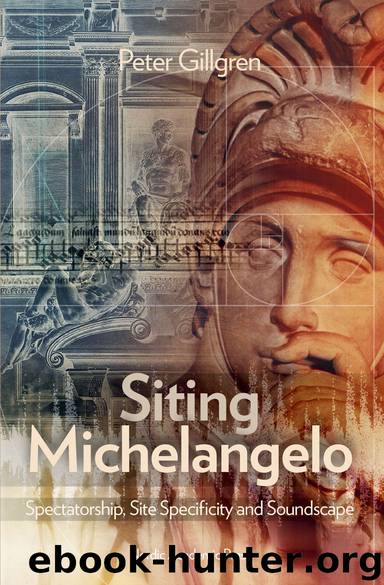Siting Michelangelo by Peter Gillgren

Author:Peter Gillgren
Language: eng
Format: epub
ISBN: 9789188661074
Publisher: NORDIC ACADEMIC PRESS
Published: 2018-01-10T16:00:00+00:00
CHAPTER 15
The Last Judgement
The Last Judgement in the Sistine Chapel is the concluding statement and climax of Michelangelo’s biblical history. This is where the world of mankind comes to an end (Fig. 1.1). Even by Michelangelo’s standards the fresco, at almost 200 square metres and with more than 300 figures, is simply overwhelming. From the grandiose design and possible artistic intentions, down to the singular figures and their expressive gestures, it has always awoken amazement, frustration, and debate.351 The work is a hurricane of terrible sounds, never before heard. All the four elements participate in the orchestration: the earth giving back its dead, water flowing in the river of Acheron, unruly winds catching at the figures, and the fires burning in hell. People cling anxiously to one another, falling, fighting, and struggling desperately; heavy bodies collide. Even the dead are screaming as they rise from their graves. The figures surrounding Christ are pleading loudly, while the protagonist himself appears as a flash of intense lightning and thunder. Below him angels trumpet insistently, adding to the welling sound of moans, complaints, and fighting figures. The angel’s trumpets relate to the Pythagorean system. According to myth, the philosopher became aware of the abstract orderliness of musical intervals when watching smiths at work in a forge. The story is illustrated by a woodcut in Franchino Gaffurio’s Theorica Musicae of 1492 (Fig. 15.1). The first image shows the smiths at work; the second, Pythagoras himself playing different instruments, concluding with pipes, marked as ‘16’ and ‘8’ long (the ratio for an octave being 2:1 for pipe lengths). In Michelangelo’s painting, the trumpets with their fixed lengths represent an orderly and well-tuned soundscape. The longer horns are echoed visually by Charon’s oar, beating off the travellers in his little bark. Only the Madonna seeks to withdraw from the turmoil, silently protracting her body and covering her ears.352 This scene is in many respects better read as a soundscape than as a text: a soundscape is more coherent and pays greater justice to its visual expressiveness than a purely iconographical interpretation can do.
Download
This site does not store any files on its server. We only index and link to content provided by other sites. Please contact the content providers to delete copyright contents if any and email us, we'll remove relevant links or contents immediately.
4 - Harry Potter and the Goblet of Fire by J.K. Rowling(2657)
2010-The City & the City by China Miéville(1945)
Wall and Piece by Banksy(1782)
Thank You for Being Late by Thomas L. Friedman(1739)
The Old Farmer's Almanac 2020 by Old Farmer’s Almanac(1661)
The Mirror and the Light by Hilary Mantel(1634)
Journey to the Abyss by Harry Kessler(1602)
The Andy Warhol Diaries by Andy Warhol(1565)
Tolkien, J. R. R. - The Fellowship of the Ring by Tolkien J. R. R(1497)
Life on Earth by David Attenborough(1434)
Art Nouveau by Carol Belanger Grafton(1398)
The Museum Of Innocence by Orhan Pamuk(1380)
Harry Potter - A History of Magic by British Library(1373)
The Business of Being an Artist by Daniel Grant(1339)
Frida by Hayden Herrera(1284)
The Future Is Japanese by(1272)
Impeach by Neal Katyal(1248)
A History of Japanese Art by Noritake Tsuda(1200)
1215 by Danny Danziger(1164)
